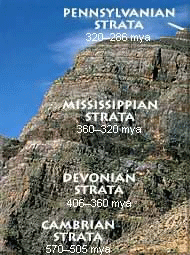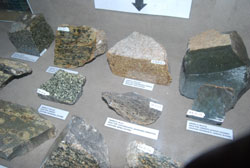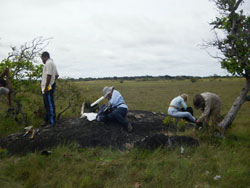AGE dating of rocks taken from the South Rupununi and Iwokrama has revealed some new and surprising insights into the geological history of Guyana.
 Rocks taken from areas in the South Rupununi have generally been found to be around 1.8 billion and to billion years old.
Rocks taken from areas in the South Rupununi have generally been found to be around 1.8 billion and to billion years old.
The surprising change is that age dating investigations of a recent batch of rocks sent by the Guyana Geology and Mines Commission (GGMC) to the University of Nanjing in China have revealed the presence in these rocks of minerals (zircon crystals) which are between five hundred million and 1,000 million years older than the rocks themselves.
This means that there had been a crust, a layer of rocks in Guyana, which existed long before two billion years ago, making parts of Guyana geologically much older than previously thought.
 Leader of the GGMC team which collected the samples, Senior Geologist Dr.Serge Nadeau, said the proterozoic rock types which were age-dated were mainly Southern Rupununi Granites from (Dadanawa and Aishalton among other villages), metamorphic rocks of the Kanuku Group, and granites and volcanics from the Iwokrama Formation, including the village of Annai, all in Region 9 (Upper Essequibo/Upper Takutu).
Leader of the GGMC team which collected the samples, Senior Geologist Dr.Serge Nadeau, said the proterozoic rock types which were age-dated were mainly Southern Rupununi Granites from (Dadanawa and Aishalton among other villages), metamorphic rocks of the Kanuku Group, and granites and volcanics from the Iwokrama Formation, including the village of Annai, all in Region 9 (Upper Essequibo/Upper Takutu).
The Chinese scientists discovered the ancient and hitherto unknown crust as crystals in these rocks.
Dr. Nadeau recently disclosed that the discovery now places the beginning of the geological history of Guyana well into the Archean Era, a period of time between 2.5 billion and 4 billion years ago, at least one billion years more than previously known.
He explained that the “exciting discovery” is a development that will definitely lead to a revision of what is known about the geological history of South America.
The scientist stressed that, within the context of the known history of the history and geology of the earth and the history of the geology of South America, the recent age dating findings on local rocks were a very significant scientific discovery.
 He said that, at the moment, the oldest known rocks, aged 4 billion years old, can be found in Canada, making that area the oldest part of earth.
He said that, at the moment, the oldest known rocks, aged 4 billion years old, can be found in Canada, making that area the oldest part of earth.
Rocks close to that age had also been found in Australia.
“These findings mean that Guyana is now among the big ones, ranking in age somewhere between Australia and Canada,” he said.
The findings also make Guyana the oldest part of South America, since prior to the recent dating results, the oldest rocks in South America had been found in Venezuela and had been aged between 3.2 billion and 3.4 billion years old.
 The oldest rock found in Brazil is age-dated at 2.9 billion years old.
The oldest rock found in Brazil is age-dated at 2.9 billion years old.
Dr. Nadeau said: “But now in Guyana, in between Venezuela and Brazil, there is something even older. There is evidence, as indicated by the zircon crystals, that there was an older crust. It disappeared. We don’t see it any more, but those crystals are telling us there was a very, very old crust, and it got modified several times, that is why you have various archean age for crystals from the more recent proterozoic era rocks in the samples.”
The rock samples had been collected late last year during a geological and geo diversity mapping exercise on the Guyana/Brazil border by the GGMC and the CPRM (Geological Survey of Brazil).
This had followed the inking of a scientific and technical cooperation agreement between the Governments of Guyana and Brazil in 2009.
Eighteen samples were sent to the University of Nanjing in China for age dating earlier this year, and the results were released recently.
The geological mapping and geo diversity mapping exercise is expected to continue in 2013, to cover the most southern areas of Guyana with Brazil, and towards Suriname, which have not yet been visited.
 Several of the proterozoic rock samples collected are currently on display at the Museum of the GGMC in Hadfield Street, Brickdam.
Several of the proterozoic rock samples collected are currently on display at the Museum of the GGMC in Hadfield Street, Brickdam.
Dr. Nadeau said that the GGMC is aware of the exact age of the ancient crust. He, however, declined to mention it, saying that the finding of the laboratory in China had been so unexpected that he needed to discuss it with South American and international experts before going public.
He said that he would be presenting the results to an international conference of geologists in Italy early next year, and then release the precise details at a press conference afterwards.
He is considering captioning his paper to the conference with the words: ”Guyana’s lost crust.”












